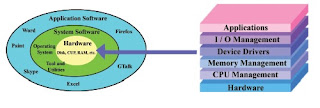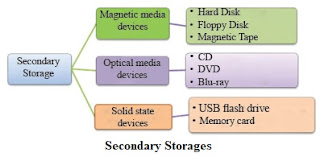Computer
A computer is a device that can be instructed to carry out sequences of arithmetic or logical operations automatically via computer programming or A computer is an electronic device that can accept data and instructions, store and process it to produce the required result.
The computer consist of hardware and software components. Both work together to process data.
Hardware
Computer hardware includes the physical, tangible parts or components of a computer, such as the central processing unit, monitor, keyboard, computer data storage, graphic card, sound card, speakers and motherboard.
or
Physical components of the computer that can be seen and touched are called as hardware. The term hardware is used to refer to all the components inside or outside the computer. In addition to this, component used to interconnect two or more components, example wire are also regarded as hardware.
- Input devices
An input device is a piece of computer hardware equipment used to provide data and control signals to an information processing system such as a computer or information appliance.
Ex:
Keyboards, mouse, touch screen, light pen, CCTV, OCR, OMR, MICR, Microphone, scanners, digital cameras, joysticks, memory card etc.
- Processing devices (System Unit)
This is the main component of a computer system. It is also called the brain of the computer as well as it functions according to the given commands. CPU manages the operating system and application software. CPU consists of three main components.
Arithmetic and Logical Unit (ALU) Perform all mathematical and logical functions. Control Unit (CU) Controls all devices of a computer
system.Memory Registers Positioned in the Central Processing
Unit. Temporarily stores data needed for
the function of ALU.- The box with processor chip(cpu), the brain of the computer, the memory chips and mother board with power supply as well as some secondary storage devices such as Floppy disk drive, hard disk drive CD, or DVD drive and Casing.
- Primary Memory
Primary memory is computer memory which is accessed directly by the CPU.
Types of primary memory
ROM (Read Only Memory)
ROM is memory containing hardwired instructions that the computer uses when it boots up, before the system software loads.
The instruction stored (non volatile) in the ROM is called the BIOS (Basic Input/ Output System).
RAM (Random Access Memory)
Temporary storage, It is volatile; when power is turned off, memory is erased.
OS and applications are loaded into RAM every times computer starts.
CACHE
Cache stores recently used information for the purpose of quickly access.
Several type of caching is used by computer for more efficient.
Ex: Browser cache, disk cache, memory cache, processor cache - Secondary Storage Device
A secondary storage device refers to any non-volatile storage device that is internal or external to the computer. It can be any storage device beyond the primary storage that enables permanent data storage. A secondary storage device is also known as an auxiliary storage device or external storage. Secondary storage or permanent storage stores data as long as we need.
Floppy Disk
Hard Disk
Compact Disk -> CD ROM,CD-R,CR-RW
Digital Versatile Disk (DVD)-> DVD ROM (read only memory), DVD-R(Recordable), DVD-RW(Rewritable)
- The box with processor chip(cpu), the brain of the computer, the memory chips and mother board with power supply as well as some secondary storage devices such as Floppy disk drive, hard disk drive CD, or DVD drive and Casing.
- Output devices
Output device is any device used to send data from a computer to another device or user.
Ex:
Soft Copy
Visual Display Units (VDU) or Monitor
Hard Copy
Printer
Graphic Output devices
Plotters
Sound
Speakers etc.
Word processing, Games, Paint, Email, Spreadsheet, Database, Desktop publishing, Designing ect.
Note
- System Software
System software is a set of master program that keep the computer working.
Components of System Software - Operating system
OS is a bridge between the computer and the user.
or
The Operating System is a software which manages the hardware and other software in a computer system. It provides services to other software. There are two main services performed by an operating system.(Managing the hardware of a computer and Providing user interface)
Managing the Hardware of a computer
Process Management
Memory Management
Device Management
File Management
Security Management
Network Management
Providing User Interface
We need an interface to interact with the computer. An Operating System provides a user interface to input commands and instructions in a user friendly manner. Using this interface, we can perform tasks without using complex instructions.
There are two types of user interfaces provided by the Operating Systems. They are:
Command Line Interface-CLI
This kind of interface was used by all the Operating System systems of the early days. This interface had a ‘prompt’ where the commands are keyed in using a keyboard.
Graphical User Interface-GUI
Almost all the present day Operating Systems use graphics on their interfaces. This GUI provides the ability to use the mouse or finger tips to navigate the commands. Therefore it has become much easier to interact with the computers today. These Operating System with GUI uses four components in order to make a friendly environment. These components are abbreviated as WIMP. WIMP stand for;
Windows
Icons
Menus
Pointer
Types of Operating System (Windows, Mac OS, UNIX, Linux, Solaris, , , )
Single user operating system (MS Dos Operating System)
Multi user operating system (Linux, Windows server)
Multi-tasking operating system (Windows 7, Windows 8, Ubuntu, Mac Operating System)
Real time operating system(ATM machines, Airlines System) - Language Software
A language acceptable to a computer system is called computer language or programming language.
It can be classified into
Machine Language
Every computer understands only one language without using a translation program which is called machine language of the computer.
A program written in machine language has the following features;
Executed directly on the machine
Fast in operation
No need of language translating programs
Dependency on machine
Difficult to understand by human as it is written in 0 and 1
Assembly Language
A language that allows instructions and storage locations to be represented by letters and symbols instead of numbers is called assembly language or symbolic language.
A program written in assembly language has the following features;
Operation is comparatively slower than machine language.
Assembly language should be translated to instructions using the language translating program called assembler.
Dependency on Machines
The use of symbols makes it more simple to understand
Note:
Machine and Assembly languages are often referred to as low-level programming languages.
High level Language
High-level programming languages overcome the limitations of low-level programming languages. The main feature of high-level languages is machine independence(portable -(can be used on different computers with or without minor changes).
Today many different high-level languages are in use because each one was designed for a different purpose.
Ex:
Logo , Fortran , Cobol , Basic , Pascal, C, C++, C#, Java, Python, RPG, LISP, Snobol etc.
Source Program and Object Program
Source Program:
A computer program written in high level language by a programmer that can be converted (or translated) into machine language.
Object Program:
A computer program translated from an equivalent source program into machine language by a compiler or assembler.
Compilers and Interpreters
Computers work in machine language. These need translators for converting different computer languages into machine language. Compilers and interpreters are translators which are also known as language processors.
Compiler
Compiler software translates a source program that is usually written in a high level language by a programmer into machine language. The compiler is capable of replacing single source program statement with a series of machine language instructions. For each language the machine requires a separate compiler.
Interpreter
Interpreter software translates each source program statement into a sequence of machine instructions and then executes these machine instructions before translating the next source language statement. Interpreter is also unique for each high level language like compiler.
- Program Utilities
Utilities are the programs that carry out general tasks such as formatting disks, storing files, virus checking.
Some examples of utilities are text editors, backup utility, compression utility, disk derangement and antivirus software.You can buy the utility programs at computer stores. Some utility programs are also available free of cost on the Internet.
There can be many types of utility programs in an Operating System:
• Backup Software - To copy files and take back up of hard drives.
• Disk scanner - To check the errors in hard drive.
• Disk defragmentation - Organizing the hard disk by rearranging clusters of small spaces together and creating a larger free space. This increases the efficiency of the hard disk.
• File/data compression - Compression of larger files into smaller files.
• Task Manager - to display information regarding the processes and programmes in a computer and the general status of the computer.
• System diagnosis tools - to monitor errors in hardware and software of a computer or network of computers and diagnosis of system errors.
• Anti-Virus Software - Protecting the computer by identifying and eliminating malicious software.
• Clipboard - temporary storage of data/files for cut/copy and paste operations.
• Data synchronization software - to establish consistency among data from a source to a target data storage and vice versa.
• Disk partitioning software - can divide an individual drive into multiple logical drives.
• Screensavers - for blanking the screen or filling it with moving images or patterns when the computer is not in use.
• System profilers - to provide detailed information about the software installed and hardware attached to the computer.
• Network utilities - to analyze the computer's network connectivity, configure network settings, check data transfer or log events. - Application Software
Application software allows the user to perform specific tasks. An application software, designed to satisfy one purpose may not be able to solve other purpose of the same user. For example, software for financial management cannot be used for designing two-dimensional graphics. Similarly, we have word processors for letter writing and presentation software for presentations. We cannot interchange the use of two application software with each other.
There are two main categories of application software: Pre-Written and Customised Application Software. Pre-Written Application Software:
These are designed for common needs of various businesses.
For example:
Word Processing (This tool is used to create letters, word sheets, type papers etc.),
Electronic Spreadsheets(A tool used to compute number intesive problems like forecasting, budgeting etc)
Presentation Software(Used to create multimedia stacks of cards/screens)
Database Management Systems(Used to store data like text informations, memberships, address etc. which helps users to sort informations accordingly.)
Communication Software(Allows to connected computers to communicate each other using audio, video or chat-based medium.)
Desktop Publishing Software(This tool is used to create illustrative worksheets, banners, newsletters, signs, gift cards etc.)
Internet Browsers(This tools allows one to surf the web, read their emails and also create web pages.) Email Programs(This software is mainly used to send and receive emails)
- Customized Application Software:
Custom software (also known as bespoke software or tailor-made software) is software that is specially developed for some specific organization or other user.
Since custom software is developed for a single customer it can accommodate that customer's particular preferences and expectations.
Large companies commonly use custom software for critical functions, including content management, inventory management, customer management, human resource management, or otherwise to fill the gaps present in the existing software packages.
Software engineers are hired to create such software. Different computer languages are used to create these software.




No comments:
Post a Comment